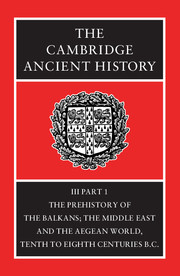Book contents
- Frontmatter
- PART I THE PREHISTORY OF THE BALKANS TO 1000 B.C.
- PART II THE MIDDLE EAST
- PART III THE BALKANS AND THE AEGEAN
- 14 The Early Iron Age in the Central Balkan Area, c. 1000–750 B.C.
- 15 Illyris, Epirus and Macedonia in the Early Iron Age
- 16 Central Greece and Thessaly
- 17 The Peloponnese
- 18a East Greece
- 18b The Islands
- 19 The Geometric Culture of Greece
- 20a The Earliest Alphabetic Writing
- 20b Greek Alphabetic Writing
- 20c Linguistic Problems of the Balkan Area in Late Prehistoric and Early Classical Periods
- 20d The Greek Language and the Historical Dialects
- 20e Balkan Languages (Illyrian, Thracian and Daco-Moesian)
- BIBLIOGRAPHY
- Index
- Map 1. The Palaeolithic and Epipalaeolithic (Mesolithic) periods in Romania
- Map 2. The Neo-Eneolithic period in Romania
- Map 3. The period of transition to the Bronze Age in Romania
- Map 4. The Bronze Age and Hallstatt A period in Romania
- Map 5. Gold and bronze hoards in Romania
- Map 13. Urartu">
- Map 17. Egypt
- References
19 - The Geometric Culture of Greece
from PART III - THE BALKANS AND THE AEGEAN
Published online by Cambridge University Press: 28 March 2008
- Frontmatter
- PART I THE PREHISTORY OF THE BALKANS TO 1000 B.C.
- PART II THE MIDDLE EAST
- PART III THE BALKANS AND THE AEGEAN
- 14 The Early Iron Age in the Central Balkan Area, c. 1000–750 B.C.
- 15 Illyris, Epirus and Macedonia in the Early Iron Age
- 16 Central Greece and Thessaly
- 17 The Peloponnese
- 18a East Greece
- 18b The Islands
- 19 The Geometric Culture of Greece
- 20a The Earliest Alphabetic Writing
- 20b Greek Alphabetic Writing
- 20c Linguistic Problems of the Balkan Area in Late Prehistoric and Early Classical Periods
- 20d The Greek Language and the Historical Dialects
- 20e Balkan Languages (Illyrian, Thracian and Daco-Moesian)
- BIBLIOGRAPHY
- Index
- Map 1. The Palaeolithic and Epipalaeolithic (Mesolithic) periods in Romania
- Map 2. The Neo-Eneolithic period in Romania
- Map 3. The period of transition to the Bronze Age in Romania
- Map 4. The Bronze Age and Hallstatt A period in Romania
- Map 5. Gold and bronze hoards in Romania
- Map 13. Urartu">
- Map 17. Egypt
- References
Summary
We owe our knowledge of Geometric Greece almost wholly to archaeology, and we name it from that style of pottery decoration by which it is most readily identified. But its importance transcends the archaeologist's terminology, for we stand also at the threshold of history: the cities and villages of Geometric Greece are those whose leagues and rivalries, whose tyrants and assemblies, are to weave the political history recorded by fifth-century and later historians; the ruling families are already established, their lands defined; representational art and writing are ‘invented’ to record and comment on both the current scene and that wealth of myth and folk tale through which later artists are to express their own views of man and his dilemmas; there is virtually nothing-of Archaic and Classical Greece – its enrichment from older cultures, its exploration of the barbarian world for new wealth or new ideas, its speculation about the place of man in the world and the role of divine justice – that cannot be seen to take its origin in the behaviour, culture, art of Geometric Greece. Yet, that said, the material culture of this world in which the new Greece is born is hard to grasp from the tangled and lacunose evidence of excavation, and is if anything harder to deduce from the allusions to contemporary life in the lines of Homer or in Hesiod's sour commentary on a Boeotian farmer's life.
Earlier chapters have explored the local history of Geometric Greek lands in terms of their emergence from the Dark Ages and in terms of their later, better documented history, some of which may, sometimes, be justly used to reflect on earlier centuries when all contemporary evidence is dumb.
- Type
- Chapter
- Information
- The Cambridge Ancient History , pp. 779 - 793Publisher: Cambridge University PressPrint publication year: 1982

